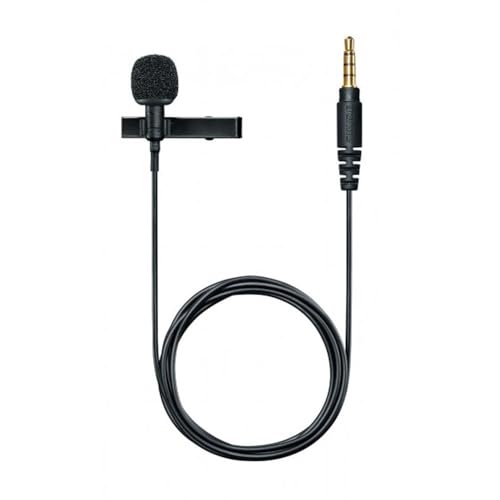The Best Lavalier Microphones

To help you find the perfect lavalier microphone, we continuously put forth the effort to update and expand our list of recommendable lavalier microphones. Our team collects, edits and publishes new information, in order to present it to you in an accurate, significant and neatly arranged way.
Our Picks
8 More Lavalier Microphone Alternatives
Table of Contents
Buying Guide
As with most production hardware, no two lapel microphones are quite the same. These differences manifest in many ways, including the price and quality of specific devices. Here's how to find options that make the most of your production budget.
Getting to Know the Lavalier Microphone
Lavalier mics capture audio without requiring that the user holds them in their hands. Most take the form of small devices that clip on to the collar or front of your shirt. The audio signals that they generate travel via wires to another piece of recording hardware, such as a control board, computer or camera. Wireless models connect to belt-mounted radio transmitters that let you pick up the sound from a distance.
Lapel mics' small form factors also make them useful in instructional settings. You may have seen college instructors or lecturers using them to present material to large audiences.
With some wired options, you can plug in to a PA system or stereo for an impromptu broadcast. Manufacturers like Movo even advertise some of their devices as being intended for use with mobile phones, although this isn't uncommon.
Lavalier microphones typically deliver lower sound quality than options like directional or boom microphones. You can, however, use them when you're creating videos where you don't want to see the sound operator in the shot. Regardless what you're doing, it's important to position your mics carefully so that they don't rub up against clothing, hair or other substances that can create loud noises in the recording.
Important Lavalier Microphone Features
Don't get overwhelmed by the huge array of lapel mics on the modern market. Just understand the following characteristics:
Microphone Type
Microphones leverage different technologies to convert sound pressure waves into electrical signals. Individual designs also have unique audio recording properties.
Varieties
Many modern lapel microphones use electret condensers that combine fair performance with low cost. For instance, devices like the Stony-Edge SIMPLE LAV and Pyle Pro's PLMC15 both promise to use the technology to produce clear sound, albeit for significantly different prices.Condenser microphones, like Audio-Technica's ATR3350, offer somewhat better output quality, but they may need external power. For instance, the ATR3350 is geared towards more active users, like fitness instructors, but you'll have to install an LR44 watch battery to keep it running.
Other devices employ dynamic technology that may deliver superior studio-grade sound in more robust packages. Dynamic mics, like the Shure SM11-CN, usually can't achieve the same small package sizes as electrets or condensers. Many are also more expensive, but if you're looking for something to capture on-stage vocals or live performances, then it may be worth paying extra.
Polar Patterns
Due to their construction, all microphones exhibit response behaviors known as polar patterns. In short, this means that they may be more sensitive to sounds coming from certain directions. For instance, omnidirectional devices like the Sennheiser ME2 should pick up identical sounds equally well from any direction as long as they originate at the same distance from the microphone.Although omni lapel mics are the most common variant, you may also see other patterns. For instance, cardioid, or unidirectional, hardware is typically sensitive to sounds coming from in front of the mic, and bi-directional devices let you capture sounds from the front or back.
Certain professional-grade devices, like the Shure MX150B/C-XLR, come in your choice of omni or cardioid options. Directional mics are better at isolating sounds, such as the wearer's speech, but they may be more expensive than generic omni models.
Frequency Response
Microphones don't capture all frequencies equally loudly. Cheap lav mics may miss out on many of the lower and higher tones.Most companies usually design their products to perform well with the mid-range frequencies contained in human speech. Some professional options, such as Audio-Technica's PRO 70, cater to musicians and performers with low-frequency roll-off switches that you can engage as needed to cut out ambient noise.
Manufacturers describe frequency performance in hertz, or Hz, ranges. Although you'll get basic functionality with a smaller range, a better response may grant you fuller sound. Higher-end manufacturers, like Rode, commonly publish frequency test results in their product listings.
Size and Weight
What difference does a couple of extra ounces make? The smallest devices may compromise on the rich sound quality you find in larger alternatives, but they're more comfortable to wear.
What should you pick? Let your usage situation be your guide. If you're creating an independent documentary, then seeing your interviewees miked up might not be too distracting for audiences, but a lav would look totally out of place in a historical period drama.
If you're lecturing, think about how long you'll have to wear the mic. Choose something that's both low-weight and easy to keep out of the way while you demonstrate concepts or move across the stage.
Wired vs. Wireless
Wireless microphones are far more expensive, but they're much more convenient when you're shooting on the go. For instance, if you're starting an online news network, then equipping your anchors with wireless lavs is a much better idea than forcing them to dodge tangled cables and stay within a certain distance of the sound engineer.
Some wireless devices also offer a bit more interchangeability. For instance, Sennheiser's ew 100-ENG G3-A lets you switch the microphone out while using the same transmitter when you eventually upgrade. On the other hand, you can achieve similar results by using plug-in devices and just ordering transmitters and other hardware separately.
Independent plug-in mics are also more compatible with items like DSLR cameras. They can be handy when you'd rather not worry about bringing your sound and video files together and lining them up properly using editing software.
Some wired lapel mics come with 3.5 mm jacks that plug in to standard line-in ports. Others sport the XLR connectors found on professional microphones. Choose whatever's compatible with your other audio capture equipment.
Construction Quality
Lavalier microphones typically receive far more abuse than studio hardware does. From scraping up against seat belts to being exposed to the weather and accidental falls, these devices must be hardy.
Fortunately, most lav mics are rugged enough to survive casual handling and usage, and the fact that they're so small can help minimize damage. With wireless devices and other hardware that requires belt-mounted attachments, however, you may have to be slightly more careful.
Finding the Perfect Lavalier Microphone
Now that you understand a bit more about lav and lapel mics, what kind will you choose? In addition to thinking about the factors listed above, pay close attention to the particulars of your shoot or project to ensure that you find a good match. For more great audio and recording tips, check out our other buying guides and blogs.
Top Rated Lavalier Microphones
If you're looking into finding the best rated lavalier microphone, you should probable check out the Shure MVL Microphone. We looked at various sources of reviews and found this one to have the best mix between review count and average rating stars.
The Lowest Price We Could Find
Often, going for the best price is a simple but good option. With a price of $21.90 (last checked this morning), we do not list any other lavalier microphone cheaper than the GODOX C01 Microphone. Just remember that it's not always the best option to go for the cheapest one.
The Lavalier Microphone With the Most Reviews
With at least 0 reviews and counting, the Shure MVL Microphone might be another option to consider. This large amount of reviews signalizes that many people are using it, with most of them beeing satisfied.
High Quality Lavalier Microphones
It's quite rare that the saying "You get what you pay for" turns out incorrect. If you have the money on the sideline, feel free to choose the most expensive item from our list: The NEEWER CM28 PRO Wireless Lapel Microphone currently sells for $99.99.
The Lavalier Microphone With the Most Clicks
If you trust us and our users, feel free to check out the Shure MVL Microphone. Our statistics say that it is the most favorite Lavalier Microphone from the list above.
Our Bestseller
If you're still undecided, I would recommend that you go with the masses and choose the top selling lavalier microphone: The NEEWER CM28 PRO Wireless Lapel Microphone is the hottest bestseller in this category right now.
Lavalier Microphone Reviews
Further Reading on Lavalier Microphones
Research
Wikipedia Article for Lavalier Microphone
… an ECM-77B made by Sony Ltd. Broadcast quality lavalier microphones are normally used for wireless microphone applications in the television broadcast industry. Unlike a conventional earphone/ microphone set 100 where …
A lavalier microphone assembly wherein ambient and mechanical interference are minimized. The assembly comprises a lavalier microphone. The microphone includes a microphone casing having an aperture for the entry of sound waves and a transducer …
A microphone assembly includes a longitudinally elongated microphone capsule which is supported within a substantially cylindrical outer casing having an electrical wire connection entering the casing from one end. The microphone is provided with an acoustic inlet at the …
Useful Videos
One of the least expensive ways to improve the quality of your video is to use a microphone that you can get close to your talent/actors. Here are six affordable ...
Comments
About this Article
It was last updated on 2025-12-16 08:10:57 and has been viewed 9142 times.


